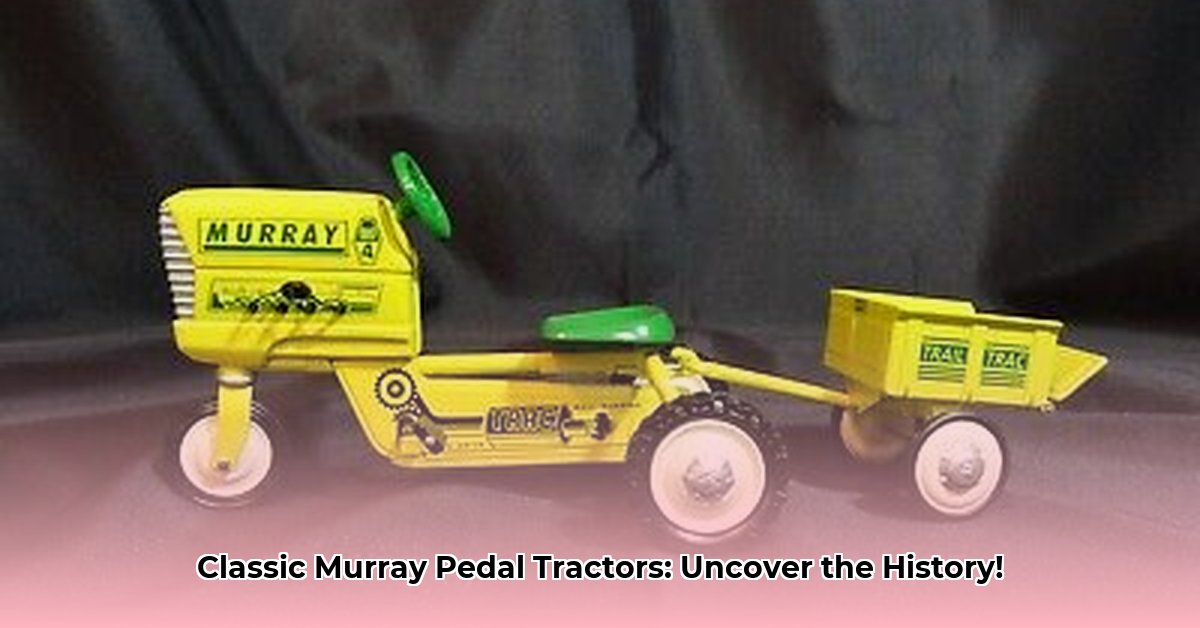
Murray Pedal Car Tractors: A Nostalgic Ride Through History
The whirring of tiny gears, the scent of freshly cut grass – the Murray pedal car tractor conjures images of idyllic childhoods. More than just toys, these miniature machines represent a unique slice of Americana, their story interwoven with the rise and fall of Murray Ohio Manufacturing and the cultural landscape of the 20th century. But their simple charm belies a surprisingly complex history, one that's still being uncovered today. For more on toy tractors, see this helpful resource.
The Murray Ohio Manufacturing Company: From Bikes to Backyard Adventures
Murray Ohio Manufacturing Company's journey began in 1910, not with toy tractors, but with bicycle parts. Imagine the clang of metal, the whirring of machinery – a scene far removed from the happy squeals of children at play. Early success in bicycle components established a foundation for their future as a toy powerhouse. Their relocation to Cleveland, Ohio, sometime after 1919, proved a strategic masterstroke. The city's burgeoning industrial base and readily available workforce provided a significant advantage.
However, precise details from these early decades remain elusive. While we know they adapted automotive manufacturing techniques originally used for bicycle parts to create durable, affordable toys, comprehensive production records from this period are scarce. This lack of readily available information adds an element of intrigue to the quest for a complete understanding of Murray's early history. Did you know, for example, that the exact date of their move to Cleveland is still debated by historians?
World War II and the Post-War Toy Boom
World War II dramatically altered Murray's trajectory. The company shifted its focus to supporting the war effort, producing essential materials for the Allied forces. This period, though challenging, inadvertently laid the groundwork for their post-war triumph. The immediate post-war era witnessed an explosion in demand for durable, engaging toys. Parents, eager to provide their children with quality playthings after years of scarcity, fueled a massive toy boom.
This presented Murray with an unparalleled opportunity. They capitalized brilliantly, producing sturdy, affordable toys that resonated with families. Enter the Murray pedal car tractor. Its design was deceptively simple – a robust steel frame and intuitive mechanics – yet profoundly effective. But it was more than just a toy; it captured the spirit of post-war America: resilience, ingenuity, and a touch of nostalgic romanticism for a bygone agricultural era. What percentage of post-war American children owned a pedal tractor? Research suggests a surprisingly high number, though exact figures are still difficult to pinpoint.
Design, Marketing, and the Allure of the Miniature Tractor
The Murray pedal car tractor's success extended beyond its robust construction. Its design was a stroke of marketing genius. These weren't merely toys; they were miniature replicas of real-world machines, embodying adventure and hard work. Early advertisements powerfully depicted children beaming with pride as they “farmed” their backyards. This astute marketing strategy highlighted Murray's deep understanding of its target audience and the potent allure of effective branding. The tractors weren't just durable; they fostered an emotional connection with their young owners, creating lasting memories.
Numerous models graced lawns over the years, each with subtle variations in detail while retaining the essential design philosophy. Early models, for instance, may have featured different paint schemes or slightly different mechanical features compared to later versions. This opens up a world of exciting possibilities for collectors and historians alike, as the hunt continues. Precise differences between models remain an area of ongoing research and discovery.
Cultural Impact: A Pedal Tractor in Every Driveway?
The Murray pedal car tractor became a ubiquitous symbol of American childhoods. Countless adults today fondly recall the sense of freedom, imaginative play, and pure joy associated with their own Murray tractor. They evoke memories of a simpler time, prompting cherished recollections for countless individuals. This enduring legacy explains their current status as highly sought-after collectibles.
Finding a well-preserved Murray pedal car tractor today resembles a treasure hunt. Collectors painstakingly restore these vintage toys, preserving a piece of American history and personal childhood memories. They meticulously examine model differences, often engaging in research based on online communities and specialized publications to identify variations and dates of manufacture. Determining the value of a specific model often involves careful research in online forums, collector groups, and consultations with experts. What is the average price of a restored, rare Murray pedal tractor today? The price varies considerably.
The Decline and the Enduring Legacy
Murray Ohio Manufacturing eventually encountered financial difficulties, ultimately leading to its closure. The precise reasons remain complex and are still being studied by economic historians. However, it is highly likely that a combination of shifting market dynamics, fiercer competition from overseas manufacturers, and evolving consumer preferences all played a significant role in their downfall.
Despite the company's demise, the legacy of the Murray pedal car tractor endures. There are enthusiasts that keep its history alive today. These miniature machines remain potent symbols of American ingenuity, simple yet effective design, and the boundless imagination of childhood. The legacy extends beyond the toys themselves; it encompasses the memories they created and the unwavering passion of collectors who keep their stories alive. While the official history of Murray concluded, the narratives surrounding their products continue to be written, one restored tractor at a time.
How to Identify Rare Early Model Murray Pedal Cars
This section provides actionable intelligence for collectors interested in rare models:
- Pre-War Models: Identify pre-World War II models through unique construction details and paint schemes.
- Model Variations: Pinpoint variations such as the Sad Face, Comet, Torpedo, and others, based on visual characteristics.
- Condition and Completeness: Assess condition, noting damage or missing parts. Original paint and chrome dramatically increase value. Consider the restoration quality if a model had been restored in the past.
These steps, combined with thorough research using online resources and collector communities, are key to identifying and evaluating the value of rare early Murray pedal tractors.